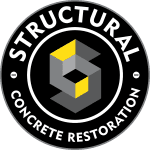
STRUCTURAL CONCRETE REPAIR IN KELOWNA & BC
At SCR we specialize in repairing structural concrete issues with precision and durability. Our process begins with a thorough inspection to assess damage such as cracks, spalling, or reinforcement corrosion. We then removed deteriorated concrete, using advanced techniques like hydrodemolition or chipping, ensuring a solid foundation for repairs. Next, we treat or replace exposed reinforcement to prevent further corrosion and apply high-performance repair materials, including epoxy injections, polymer-modified mortars, or fiber-reinforced composites, to restore strength and integrity. To enhance durability, we also use protective coatings and waterproofing solutions as needed. With a commitment to quality and industry standards, SCR ensures every repair extends the life and safety of your concrete structures.
Is your home’s concrete showing signs of wear and damage?
At SCR, we ensure that every structural concrete repair blends seamlessly with the existing structure by using specialized application methods. Depending on the project, we can form, spray, or pump concrete into the repair area to achieve the customer’s desired finish. Our team carefully shapes and textures the repaired surface to match the original appearance while maintaining structural integrity. Whether it’s a smooth, troweled finish or more complex architectural detail, we use precision techniques to deliver durable, high-quality results that restore both function and esthetics.
OUR PROCESS
Serving Kelowna, Vernon, Penticton, Kamloops, and Rest of Okanagan Valley
Leaving repairs unattended can lead to bigger problems down the line. That’s why we prioritize a quick and straightforward process to restore your concrete with minimal disruption. Our team not only repairs but also identifies potential causes, helping prevent future issues.
Thorough Inspections
Every project begins with a comprehensive inspection to uncover the root cause of the problems, from foundation shifts to surface damage. We provide a clear, easy-to-understand summary so you’re fully aware of the repair scope, whether it’s foundation repair, slab lifting, or crack injections for long-term structural integrity.
Accurate Estimates
Transparency is key—our detailed estimates mean you know what to expect, with no hidden surprises. Our approach ensures a clear path forward on cost and timeline, minimizing unexpected costs.
Seamless Repairs
Our experts complete repairs with speed and care. Using advanced concrete crack injection methods, we make sure the area is clean and secure, leaving your property in better shape than before. Choose reliable concrete repair services that last.
EPOXY PRESSURE INJECTION
Epoxy injection is a highly effective method for preventing structural concrete issues before they become major problems. At SCR, we use epoxy injection to seal cracks and prevent water infiltration, which can lead to corrosion of reinforcing steel and further concrete deterioration. This process involves injecting a high-strength epoxy resin into cracks under pressure, bonding the concrete back together, and restoring its original strength. By sealing these vulnerabilities early, epoxy injection prevents moisture penetration, freeze-thaw damage, and chemical intrusion, all of which contribute to long-term structural issues. This proactive approach not only extends the life of concrete structures but also reduces the need for costly repairs in the future, ensuring durability and reliability for years to come.
COMMON APPLICATIONS OF EPOXY PRESSURE INJECTION:
- Structurally re-bonding cracked concrete
- Re-bonding delaminated concrete toppings and bridge decks.
- Repairing leaks due to cracks in foundation walls and suspended slabs
- Seal pipe penetrations
- Bond steel plates to concrete
- Anchoring bolts, dowels and re-enforcing bars
- Filling porous or honeycombed concrete
STRUCTURES WHERE THIS PROCESS HAS BEEN SUCCESSFULLY USED:
- Buildings—floors, walls and suspended slabs
- Highway and airport pavement
- Columns and beams
- Bridges, piers and dams
- Water treatment facilities
- Tunnels and pipe
- Tanks and silos
- Power plants
- Parking structures
- Earthquake-damaged structures








